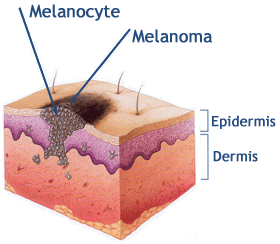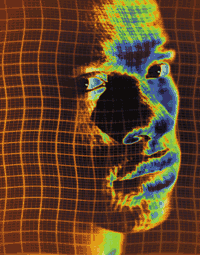.: Click here to download :.
Malignant melanoma is nowadays one of the leading cancers among
many white-skinned populations around the world. Change of recreational
behavior together with the increase in ultraviolet radiation cause
a dramatic increase in the number of melanomas diagnosed. The raise
in incidence was first noticed in the United States in 1930, where one
person out of 100 000 per year suffered from skin cancer. This rate
increased in the middle of the eighties to six per 100 000 and to
13 per 100 000 in 1991. The numbers are also comparable to the incidence
rates observed in Europe. In 1995, in Austria the incidence of
melanoma was about 12 per 100 000, which reflected an increase of
51.8 % in the previous ten years, and the incidence of melanoma
shows a still increasing tendency.
But on the other hand investigations have shown that the curability of
skin cancer is nearly 100%, if it is recognized early enough and treated
surgically. Whereas the mortality rate caused by melanomas in the
early sixties was about 70 %, nowa survival rate of 70% is achieved,
which is mainly the result of early recognition.
Because of the higher incidence of malignant melanoma, researchers
are concerned more and more with the automated diagnosis of skin lesions.
Many publications report on isolated efforts into the direction
of automated melanoma recognition by image processing. Complete
integrated dermatological image analysis systems are hardly found in
clinical use, or are not tested on a significant number of real-life samples.
We have developed a fast and reliable system that is capable to detect
and classify skin
lesions with high accuracy. We use color images of skin lesions,
image processing techniques and AdaBoost classifier to distinguish
melanoma from benign pigmented lesions. As the first step of the data
set analysis, a preprocessing sequence is implemented to remove noise
and undesired structures from the color image. Second, an automated
segmentation approach localizes suspicious lesion regions by region
growing after a preliminary step based on adaptive color segmentation.
Then, we rely on quantitative image analysis to measure a series of
candidate attributes hoped to contain enough information to
differentiate melanomas from benign lesions. At last, the selected
features are supplied to AdaBoost algorithm to build a strong
classifier.
Using Leave-one-out cross validation on Zagrouba's image dataset (95
images of benign nevi and 25 images of malignant melanoma) we have
obtained an excellent recognition rate of 86.10%.
E. Zagrouba, W. Barhoumi, "Prelimary Approach For The Automated
Recognition Of Malignant Melanoma", this paper is available
here.
Index Terms: Matlab, source, code, melanoma recognition, detection, skin lesion, malignant melanoma, nevus.
 |
Figure 1. Melanoma |
||||||||||||||
|
A simple and effective source code for Melanoma Recognition. |
|||||||||||||||
Demo code (protected
P-files) available for performance evaluation. Matlab Image Processing Toolbox, Matlab Signal Processing Toolbox and Matlab Wavelet Toolbox are required. |
|||||||||||||||
|
Release |
Date |
Major features |
|||||||||||||
|
1.0 |
2011.02.23 |
|
|||||||||||||
We recommend to check the secure connection to PayPal, in order to avoid any fraud. This donation has to be considered an encouragement to improve the code itself. |
|||||||||||||||
Melanoma Recognition System - Click here for
your donation. In order to obtain the source code you
have to pay a little sum of money: 400 EUROS (less
than 560 U.S. Dollars). |
|||||||||||||||
Once you have done this, please email us luigi.rosa@tiscali.it As soon as possible (in a few days) you will receive our new release of Melanoma Recognition System. Alternatively, you can bestow using our banking coordinates:
|
|||||||||||||||
The authors have no relationship or partnership
with The Mathworks. All the code provided is written in Matlab
language (M-files and/or M-functions), with no dll or other
protected parts of code (P-files or executables). The code was
developed with Matlab 2006a. Matlab Image Processing Toolbox, Matlab Signal Processing Toolbox and Matlab Wavelet Toolbox are required.
The code provided has to be considered "as is" and it is without any kind of warranty. The
authors deny any kind of warranty concerning the code as well
as any kind of responsibility for problems and damages which may
be caused by the use of the code itself including all parts of
the source code.

